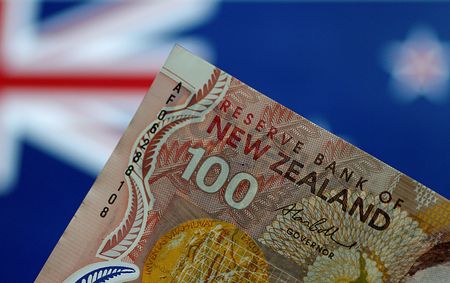
By Kevin Buckland
TOKYO (Reuters) – The New Zealand dollar traded an early decline for a big gain on Wednesday after a hawkish tilt from the country’s central bank, while the greenback bounced off a one-month low amid a stabilisation in Treasury yields.
The kiwi reversed losses as steep as 0.53% ahead of the Reserve Bank of New Zealand interest rate decision to gain as much as 0.61%, hitting a three-week peak of $0.65 immediately afterward. It last traded 0.43% higher at $0.6488.
The RBNZ raised the key rate by half a point, as widely expected, but released more hawkish guidance on its future policy path, saying that a larger and earlier hike reduces the risk of inflation becoming persistent.
Meanwhile, the U.S. dollar index – which measures the currency against six major rivals – rallied 0.16% to 101.92, pulling away from its overnight low at 101.64, a level not seen since April 26.
The index retreated 1.23% over the first two days of this week, taking it ever further from the nearly two-decade high above 105 marked mid-month amid a decline in benchmark Treasury yields as traders positioned for a slightly less aggressive path of Federal Reserve rate hikes.
The 10-year Treasury yield edged up to 2.7631% in Tokyo trading, after dipping to a nearly one-month low of 2.718% overnight.
The dollar edged 0.08% higher against its Japanese peer, which is highly sensitive to moves in long-term Treasuries, to trade at 126.945 yen. That’s after sliding to a more than five-week low at 126.37 yen in the previous session.
The euro retreated 0.22% to $1.07105, but remained near Tuesday’s high of $1.0748, a level not seen since April 25, after European Central Bank President Christine Lagarde said euro zone interest rates will likely be in positive territory by the end of the third quarter.
Lagarde’s comments implied an increase of at least 50 basis points to the deposit rate and fuelled speculation of bigger hikes this summer.
Monetary policy outlooks have steered foreign-exchange markets this week, and traders will be looking for more clues about the pace of Fed tightening over the rest of this year when minutes of the last rate-setting meeting are released later in the global day.
Atlanta Fed President Raphael Bostic warned that headlong rate hikes could create “significant economic dislocation,” urging his colleagues to “proceed carefully,” in an essay published Tuesday.
“It is unclear whether we are getting closer to the Fed put, but it is clear that growth headwinds are becoming more evident,” Tapas Strickland, a markets economist at National Australia Bank, wrote in a client note.
“The Fed of course remains focused on inflation, but if inflation reads were (to) start to moderate, then Bostic has opened up the possibility of a Fed pause.”
Elsewhere, sterling slipped 0.12% to $1.2521, while the Aussie dollar dropped 0.23% to $0.70905.
Cryptocurrency bitcoin continued its two-week-long consolidation around $30,000, last trading 1.24% higher at 29,998.34.
(Reporting by Kevin Buckland; Editing by Sonali Desai)

